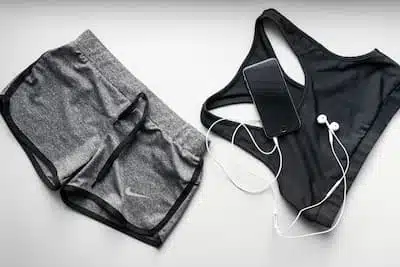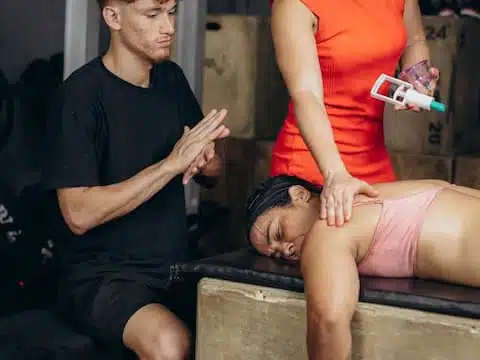When preparing for a sports massage, what you wear can make a significant difference in your comfort, mobility, and treatment effectiveness. Whether it’s your first session or you’re a regular, understanding the best clothing choices will help you get the most out of your treatment.
This guide will walk you through what to wear (and what to avoid) for men and women, considerations for specific techniques like cupping or IASTM, and what to bring for a smooth session.
Why Clothing Matters in a Sports Massage
Unlike a traditional relaxation massage, a sports massage focuses on movement, deep tissue work, and mobility techniques. The therapist may use techniques such as:
- PNF stretching – requiring flexibility in clothing
- Spinal manipulations – needing access to the spine
- Cupping therapy – involving skin exposure for suction
- IASTM (Instrument-Assisted Soft Tissue Mobilization) – requiring direct skin contact
Wearing the right clothing allows your therapist to target the affected muscles effectively while ensuring you feel comfortable and not exposed unnecessarily.
What to Wear for a Sports Massage
For Men:
- Shorts (above the knee, loose-fitting) – Ideal for working on quads, hamstrings, and calves. Avoid restrictive shorts that limit stretching.
- Loose or sleeveless tops – If you’re having upper body work done, a tank top or a loose t-shirt provides accessibility. More than likely you’ll be asked to remove this.
🔹 Avoid: Jeans, tight joggers, or restrictive leggings that limit movement.
For Women:
- Sports bra or strappy top – Provides coverage while allowing access to the shoulders and back.
- Shorts or flexible leggings – Opt for looser, breathable fabrics, especially if your therapist needs access to your legs. Shorts are preffered.
🔹 Avoid: One-piece bodysuits, restrictive high-waisted leggings, or thick fabric sports bras that limit shoulder mobility. And especially avoid any clothing you don’t want any oil on.
Special Considerations for Specific Treatments
If your session includes specialized techniques, you may need to adjust your outfit for better results:
✅ Cupping Therapy
- Clothing should allow easy access to areas being treated (e.g., back, shoulders, or legs). You will likely be asked to remove an item of clothing (t-shirt).
- For back cupping, a sports bra or loose t-shirt that can be lifted is best.
- Dark, thick and loose clothing is preferred so not potential blood stains seep through following wet cupping
✅ IASTM (Rockblade, Graston Therapy)
- The therapist will need direct skin contact for the tool to glide properly.
- Wearing shorts or a loose top makes access easier.
✅ PNF Stretching
- Stretching techniques require unrestricted movement.
- Loose or flexible athletic wear is best, avoiding stiff fabrics, especially for leggings/bottoms.
✅ Spinal Manipulations
- Your therapist may need access to the spine and shoulders.
- Avoid thick, layered clothing that restricts contact. Likely you will be asked to remove extra layers for this.
Naturally, this should all be communicated before your session commences.
What to Bring to Your Session
📌 Water Bottle – Hydration before and after your session helps with muscle recovery.
📌 Hair Tie (if needed) – Keeping hair out of the way makes head and neck work significantly easier.
📌 Comfortable Slip-On Shoes – Avoid tight boots or restrictive footwear that are difficult to put on or remove, you will need to remove them regardless.
📌 A Change of Clothes (if needed) – If you’re receiving cupping or oil-based therapy, bringing an extra shirt can be useful (or just wear appropriate clothing from the get go)
Common Questions About What to Wear
🔹 Do I have to undress completely?
No, but some treatments require direct skin access. Your therapist will ensure your comfort and drape you appropriately. Do not be pressured into removing items of clothing when you are not comfortable, your therapist should have towel at hand to cover areas that aren’t being worked on to avoid unecessary exposure of your skin.
🔹 Can I wear leggings?
Yes, but they should be stretchable and lightweight. Avoid thick compression leggings that restrict movement. If working on your upper body, you can wear whatever type of leggings you’d like. If working on your legs, leggings are inappropriate and shorts would be required.
🔹 What if I’m coming from work?
You can bring a change of clothes to switch into more suitable attire before your session.
Dress for Comfort and Effectiveness
What you wear to a sports massage directly affects your mobility, comfort, and the effectiveness of the treatment. Choose loose, flexible clothing that allows your therapist to work efficiently while keeping you comfortable.
By preparing ahead, you’ll maximize the benefits of your sports massage—helping you move better, recover faster, and feel great after every session.
If you’re booking a session with us, be sure to check out our Session Preparation Page for everything you need to know before your appointment, including what to expect, how to prepare, and post-session tips to get the best results.

